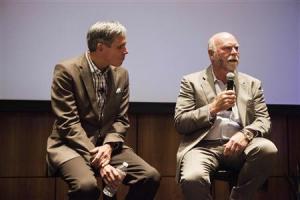The Future of Brain Implants
How soon can we expect to see brain implants for perfect memory, enhanced vision, hypernormal focus or an expert golf swing?
By Gary Marcus and Christof Koch
March 14, 2014 7:30 p.m. ET
What would you give for a retinal
chip that let you see in the dark or for a next-generation cochlear
implant that let you hear any conversation in a noisy restaurant, no
matter how loud? Or for a memory chip, wired directly into your brain's
hippocampus, that gave you perfect recall of everything you read? Or for
an implanted interface with the Internet that automatically translated a
clearly articulated silent thought ("the French sun king") into an
online search that digested the relevant Wikipedia page and projected a
summary directly into your brain?
Science
fiction? Perhaps not for very much longer. Brain implants today are
where laser eye surgery was several decades ago. They are not risk-free
and make sense only for a narrowly defined set of patients—but they are a
sign of things to come.
Unlike
pacemakers, dental crowns or implantable insulin pumps,
neuroprosthetics—devices that restore or supplement the mind's
capacities with electronics inserted directly into the nervous
system—change how we perceive the world and move through it. For better
or worse, these devices become part of who we are.
Neuroprosthetics
aren't new. They have been around commercially for three decades, in
the form of the cochlear implants used in the ears (the outer reaches of
the nervous system) of more than 300,000 hearing-impaired people around
the world. Last year, the Food and Drug Administration approved the
first retinal implant, made by the company Second Sight.
Both
technologies exploit the same principle: An external device, either a
microphone or a video camera, captures sounds or images and processes
them, using the results to drive a set of electrodes that stimulate
either the auditory or the optic nerve, approximating the naturally
occurring output from the ear or the eye.
Another type of now-common implant,
used by thousands of Parkinson's patients around the world, sends
electrical pulses deep into the brain proper, activating some of the
pathways involved in motor control. A thin electrode is inserted into
the brain through a small opening in the skull; it is connected by a
wire that runs to a battery pack underneath the skin. The effect is to
reduce or even eliminate the tremors and rigid movement that are such
prominent symptoms of Parkinson's (though, unfortunately, the device
doesn't halt the progression of the disease itself). Experimental trials
are now under way to test the efficacy of such "deep brain stimulation"
for treating other disorders as well.
Electrical
stimulation can also improve some forms of memory, as the neurosurgeon
Itzhak Fried
and his colleagues at the University of California, Los Angeles,
showed in a 2012 article in the New England Journal of Medicine. Using a
setup akin to a videogame, seven patients were taught to navigate a
virtual city environment with a joystick, picking up passengers and
delivering them to specific stores. Appropriate electrical stimulation
to the brain during the game increased their speed and accuracy in
accomplishing the task.
But not all
brain implants work by directly stimulating the brain. Some work instead
by reading the brain's signals—to interpret, for example, the
intentions of a paralyzed user. Eventually, neuroprosthetic systems
might try to do both, reading a user's desires, performing an action
like a Web search and then sending the results directly back to the
brain.
How close are we to having such
wondrous devices? To begin with, scientists, doctors and engineers need
to figure out safer and more reliable ways of inserting probes into
people's brains. For now, the only option is to drill small burr-holes
through the skull and to insert long, thin electrodes—like pencil
leads—until they reach their destinations deep inside the brain. This
risks infection, since the wires extend through the skin, and bleeding
inside the brain, which could be devastating or even fatal.
External
devices, like the brainwave-reading skull cap made by the company
NeuroSky (marketed to the public as "having applications for wellness,
education and entertainment"), have none of these risks. But because
their sensors are so far removed from individual neurons, they are also
far less effective. They are like Keystone Kops trying to eavesdrop on a
single conversation from outside a giant football stadium.
Today, effective brain-machine
interfaces have to be wired directly into the brain to pick up the
signals emanating from small groups of nerve cells. But nobody yet knows
how to make devices that listen to the same nerve cells that long. Part
of the problem is mechanical: The brain sloshes around inside the skull
every time you move, and an implant that slips by a millimeter may
become ineffective.
Another part of the
problem is biological: The implant must be nontoxic and biocompatible
so as not to provoke an immune reaction. It also must be small enough to
be totally enclosed within the skull and energy-efficient enough that
it can be recharged through induction coils placed on the scalp at night
(as with the recharging stands now used for some electric
toothbrushes).
These obstacles may seem
daunting, but many of them look suspiciously like the ones that
cellphone manufacturers faced two decades ago, when cellphones were
still the size of shoeboxes. Neural implants will require even greater
advances since there is no easy way to upgrade them once they are
implanted and the skull is sealed back up.
But
plenty of clever young neuro-engineers are trying to surmount these
problems, like
Michel Maharbiz
and
Jose Carmena
and their colleagues at the University of California, Berkeley.
They are developing a wireless brain interface that they call "neural
dust." Thousands of biologically neutral microsensors, on the order of
one-tenth of a millimeter (approximately the thickness of a human hair),
would convert electrical signals into ultrasound that could be read
outside the brain.
The real question
isn't so much whether something like this can be done but how and when.
How many advances in material science, battery chemistry, molecular
biology, tissue engineering and neuroscience will we need? Will those
advances take one decade, two decades, three or more? As Dr. Maharbiz
said in an email, once implants "can be made 'lifetime stable' for
healthy adults, many severe disabilities…will likely be chronically
treatable." For millions of patients, neural implants could be
absolutely transformative.
Assuming that
we're able to clear these bioengineering barriers, the next challenge
will be to interpret the complex information from the 100 billion tiny
nerve cells that make up the brain. We are already able to do this in
limited ways.
Based on decades of prior
research in nonhuman primates,
John Donoghue
of Brown University and his colleagues created a system called
BrainGate that allows fully paralyzed patients to control devices with
their thoughts. BrainGate works by inserting a small chip, studded with
about 100 needlelike wires—a high-tech brush—into the part of the
neocortex controlling movement. These motor signals are fed to an
external computer that decodes them and passes them along to external
robotic devices.
Almost a decade ago, this system was
used by a tetraplegic to control an artificial hand. More recently, in a
demonstration of the technology's possibilities that is posted on
YouTube,
Cathy Hutchinson,
paralyzed years earlier by a brainstem stroke, managed to take a
drink from a bottle of coffee by manipulating a robot arm with only her
brain and a neural implant that literally read (part of) her mind.
For
now, guiding a robot arm this way is cumbersome and laborious, like
steering a massive barge or an out-of-alignment car. Given the current
state of neuroscience, even our best neuroscientists can read the
activity of a brain only as if through a glass darkly; we get the gist
of what is going on, but we are still far from understanding the
details.
In truth, we have no idea at
present how the human brain does some of its most basic feats, like
translating a vague desire to return that tennis ball into the torrent
of tightly choreographed commands that smoothly execute the action. No
serious neuroscientist could claim to have a commercially ready
brain-reading device with a fraction of the precision or responsiveness
of a computer keyboard.
In understanding
the neural code, we have a long way to go. That's why the federally
funded BRAIN Initiative, announced last year by President
Barack Obama,
is so important. We need better tools to listen to the brain and
more precise tools for sending information back to the brain, along with
a far more detailed understanding of different kinds of nerve cells and
how they fit together in complex circuits.
The
coarse-grained functional MRI brain images that have become so popular
in recent years won't be enough. For one thing, they are indirect; they
measure changes not in electrical activity but in local blood flow,
which is at best an imperfect stand-in. Images from fMRIs also lack
sufficient resolution to give us true mastery of the neural code. Each
three-dimensional pixel (or "voxel") in a brain scan contains a
half-million to one million neurons. What we really need is to be able
to zero in on individual neurons.
Zooming
in further is crucial because the atoms of perception, memory and
consciousness aren't brain regions but neurons and even finer-grained
elements. Chemists turned chemistry into a quantitative science once
they realized that chemical reactions are (almost) all about electrons
making and breaking bonds among atoms. Neuroscientists are trying to do
the same thing for the brain. Until we do, brain implants will be
working only on the logic of forests, without sufficient understanding
of the individual trees.
One of the most
promising tools in this regard is a recently developed technique called
optogenetics, which hijacks the molecular machinery of the genes found
inside every neuron to directly manipulate the brain's circuitry. In
this way, any group of neurons with a unique genetic ZIP Code can be
switched on or off, with unparalleled precision, by brief pulses of
different colored light—effectively turning the brain into a piano that
can be played. This fantastic marriage of molecular biology with optics
and electronics is already being deployed to build advanced retinal
prosthetics for adult-onset blindness. It is revolutionizing the whole
field of neuroscience.
Advances in
molecular biology, neuroscience and material science are almost
certainly going to lead, in time, to implants that are smaller, smarter,
more stable and more energy-efficient. These devices will be able to
interpret directly the blizzard of electrical activity inside the brain.
For now, they are an abstraction, something that people read about but
are unlikely to experience for themselves. But someday that will change.
Consider the developmental arc of
medical technologies such as breast surgery. Though they were pioneered
for post-mastectomy reconstruction and for correcting congenital
defects, breast augmentation and other cosmetic procedures such as
face-lifts and tummy tucks have become routine. The procedures are
reliable, effective and inexpensive enough to be attractive to broad
segments of society, not just to the rich and famous.
Eventually
neural implants will make the transition from being used exclusively
for severe problems such as paralysis, blindness or amnesia. They will
be adopted by people with less traumatic disabilities. When the
technology has advanced enough, implants will graduate from being
strictly repair-oriented to enhancing the performance of healthy or
"normal" people. They will be used to improve memory, mental focus
(Ritalin without the side effects), perception and mood (bye, bye
Prozac).
Many people will resist the
first generation of elective implants. There will be failures and, as
with many advances in medicine, there will be deaths. But anybody who
thinks that the products won't sell is naive. Even now, some parents are
willing to let their children take Adderall before a big exam. The
chance to make a "superchild" (or at least one guaranteed to stay calm
and attentive for hours on end during a big exam) will be too tempting
for many.
Even if parents don't invest in brain
implants, the military will. A continuing program at Darpa, a Pentagon
agency that invests in cutting-edge technology, is already supporting
work on brain implants that improve memory to help soldiers injured in
war. Who could blame a general for wanting a soldier with hypernormal
focus, a perfect memory for maps and no need to sleep for days on end?
(Of course, spies might well also try to eavesdrop on such a soldier's
brain, and hackers might want to hijack it. Security will be paramount,
encryption de rigueur.)
An early
generation of enhancement implants might help elite golfers improve
their swing by automating their mental practice. A later generation
might allow weekend golfers to skip practice altogether. Once
neuroscientists figure out how to reverse-engineer the end results of
practice, "neurocompilers" might be able to install the results of a
year's worth of training directly into the brain, all in one go.
That
won't happen in the next decade or maybe even in the one after that.
But before the end of the century, our computer keyboards and trackpads
will seem like a joke; even Google Glass 3.0 will seem primitive. Why
would you project information onto your eyes (partly occluding your
view) when you could write information into your brain so your mind can
directly interpret it? Why should a computer wait for you to say or type
what you mean rather than anticipating your needs before you can even
articulate them?
By the end of this
century, and quite possibly much sooner, every input device that has
ever been sold will be obsolete. Forget the "heads-up" displays that the
high-end car manufactures are about to roll out, allowing drivers to
see data without looking away from the road. By the end of the century,
many of us will be wired directly into the cloud, from brain to toe.
Will these devices make our society as a whole happier, more peaceful and more productive? What kind of world might they create?
It's
impossible to predict. But, then again, it is not the business of the
future to be predictable or sugarcoated. As President
Ronald Reagan
once put it, "The future doesn't belong to the fainthearted; it
belongs to the brave."
The augmented
among us—those who are willing to avail themselves of the benefits of
brain prosthetics and to live with the attendant risks—will outperform
others in the everyday contest for jobs and mates, in science, on the
athletic field and in armed conflict. These differences will challenge
society in new ways—and open up possibilities that we can scarcely
imagine.
Dr. Marcus is professor of
psychology at New York University and often blogs about science and
technology for the New Yorker. Dr. Koch is the chief scientific officer
of the Allen Institute for Brain Science in Seattle.

















